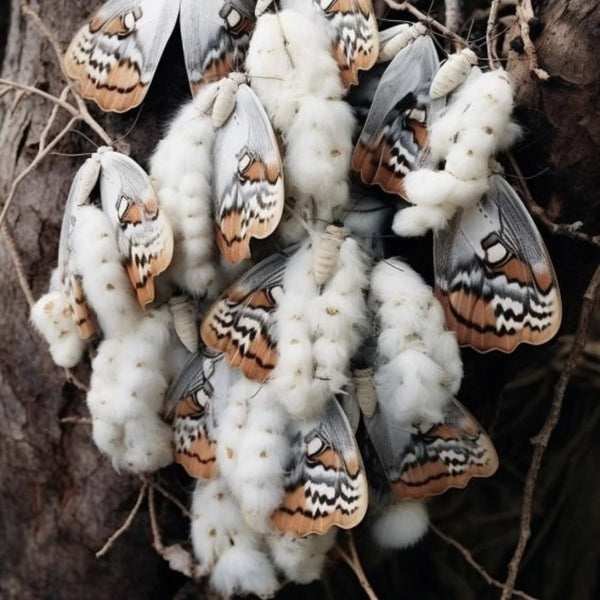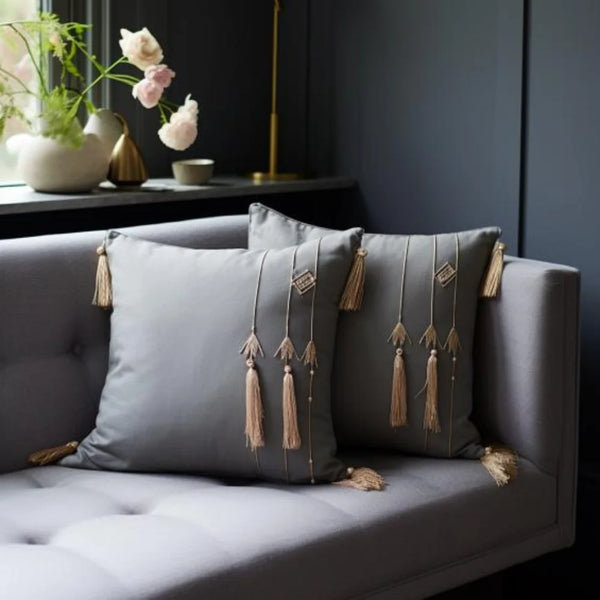Key Takeaways
tussah silk is a wild silk produced by silkworms feeding on oak leaves. It is distinguished by its rough texture, its raw appearance and its natural nuances.
Thanks to its environmentally friendly production process and its great robustness, tussah silk combines durability, elegance and versatility. It is used in haute couture, interior decoration, crafts and DIY projects.
The French brand The Oversized Hoodie® 🇫🇷 is famous for its textile expertise, particularly its collection of high-end, 100% natural mulberry silk products certified Oeko-Tex® Standard 100.
Free from toxic and chemical substances, and ecological, the collections grade 6A silk pillowcase, silk sleep mask and silk sheets stand out for their incomparable softness and excellent value for money, providing an unrivaled feeling of comfort.
Origin and characteristics of tussah silk
Origin and History
Tussah silk takes its name from the Tussah region of India, where it was originally produced. Harvested in the wild in the forests, it is the fruit of the work of the silkworm Antheraea mylitta, which feeds on oak leaves instead of mulberries like the silkworm. silk from bombyx mori producing classic silk.
Unique Features
Unlike classic silk, tussah silk has a rougher texture to the touch. Its raw and matte appearance gives it an authentic finish tending to brown, beige or gray.
As the tussah silk production process is more respectful of the environment and silkworms, the fiber produced is very robust and durable.

Also read: What are the different types of silk ?
Manufacturing process: from worm to fiber
The production process of tussah silk begins with harvesting the cocoons woven by silkworms Antheraea mylitta in the wild in the forests. Once collected, the cocoons are sorted in order to keep only the best ones for the extraction of the silk.
The selected cocoons are then immersed in hot water to soften the resin covering them and allow the silk threads to be unwound. Several threads are then joined together in a process called milling to form a thicker, stronger thread.
Unlike classic silk which requires going to the digging stage to remove the sericin covering it, tussah silk keeps its raw appearance once spun, which gives it this characteristic rough texture.

Also read: What is mulberry silk ?
Common uses of tussah silk
Fashion and Textiles
Thanks to its unique texture and its great robustness, tussah silk is used both in haute couture and in the making of more casual chic clothing. It is found in high-end textile creations, sought after for their authentic style and durability.
Within the The Oversized Hoodie® team, we are fascinated by the creative possibilities that tussah silk offers.Its unique texture inspired us to create models combining a raw spirit and relaxed elegance, in the image of our brand.
— Geoffrey, Founder of The Oversized Hoodie®
Combined with other natural fibers such as linen or cotton, tussah silk brings a touch of originality to fabrics while maintaining a raw appearance which is more attractive in addition to stylists.

Interior Decoration
In interior decoration, tussah silk is very popular for its versatility. It allows you to design wall hangings or cushions in natural and sophisticated shades.
It is also found in high-end tapestries or bed sets. tussah silk gives interiors an authentic style full of character.
Crafts and DIY Projects
Easy to work with, tussah silk is the ideal ally for carrying out artisanal and DIY creative hobbies.
It allows you to design all kinds of fashion and decorative accessories: scarves, stoles, cushions, lampshades and many more!
Its rough texture lends itself perfectly to weaving, dyeing with natural dyes and even bobbin lace. Resistant and versatile, tussah silk gives free rein to your imagination for unique creations!

Also read: What is silk satin ?
Advantages of tussah silk
Sustainability
Unlike the very delicate classic silk, tussah silk is renowned for its strength and durability to any test. It retains its shape and color well even after multiple washes.
This exceptional longevity is due to its production process that respects the natural cycle of silkworms and is free from any aggressive chemical treatment.
At The Oversized Hoodie®, we attach particular importance to natural and eco-responsible materials. Tussah silk perfectly reflects this commitment with its environmentally friendly production process.
— Geoffrey, Founder of The Oversized Hoodie®
Resistance
Thanks to its thick texture and raw appearance, tussah silk is much more resistant than other types of silk. It does not crack and supports friction and tension well.
This great robustness allows it to retain all its integrity even in applications subject to high demand such as furniture or fashion accessories.
Comfort
Despite its rough nuances, tussah silk provides a unique sensation of softness and comfort to the touch. Its authentic texture and changing reflections give it an exceptional drape.
Light and breathable, it adapts perfectly to the shape of the body without restricting movements. The raw feel of tussah silk seduces even the most sensitive skin.
Luxury
With its raw and authentic appearance, tussah silk conveys an image of discreet luxury and natural elegance which appeals to lovers of noble materials.
Sustainable and environmentally friendly, it perfectly embodies the values of modern luxury, both ethical and aesthetic. Tussah silk gives character and refinement to the most demanding creations.
Versatility of Use
Thanks to its exceptional strength and its great ease of dyeing, weaving and making, tussah silk is used in a multitude of applications: haute couture, furniture, decoration, textile crafts, etc.
Whether it's making an evening dress, a designer cushion or a macramé frame, everything is possible with this silk that is both wild and sophisticated!
Also read: The Synthetic Silk Revolution: Between Innovation and Sustainability
Tussah silk in weaving and bobbin lace
The rough texture of tussah silk makes it an exceptional fiber for creating unique pieces in weaving or bobbin lace.
Combined with other natural fibers such as linen or cotton, it makes it possible to design fabrics with subtle and changing shades. Artisan weavers appreciate its rustic and authentic grain.
In bobbin lace, tussah silk reveals all its finesse and delicacy to give birth to airy and vaporous pieces. A perfect marriage between raw material and sophisticated lace!

Also read: Silk Chiffon: Luxury and Lightness
Comparison: 20/2 tussah silk and 20 2 thread
The denomination 20/2 for silk indicates the count, that is to say the diameter of the thread. The higher the number, the finer the wire.
Thus, a tussah silk 20/2 will be finer and lighter than a 12/2 silk. It will be perfect for making bobbin lace or openwork weaving.
The thread 20 2 without mention of the material simply refers to a cotton thread of count 20. It is a thicker thread with less shine than silk.
Where to buy natural tussah silk ?
To obtain authentic tussah silk for your creative projects, turn to suppliers and boutiques specializing in high-end textiles and fibers nobles.
Many haberdashery stores also offer tussah silk for knitting, crocheting or weaving.
Finally, more and more online stores allow you to order this precious silk directly from home. Do not hesitate to compare the different qualities offered.

Conclusion
With its authentic rendering and its very particular rough texture, tussah silk is attracting more and more lovers of noble and natural materials.
Durable, strong and easy to work with, it opens the way to a multitude of textile creations combining refinement and raw spirit. Whether it is fashion, decoration or crafts, tussah silk brings a touch of wild elegance and timelessness to all your creations.
| Characteristic | Description | Advantages | Uses |
|---|---|---|---|
| Origin | Produced by silkworms Antheraea mylitta | Sustainability and respect for the environment | Haute couture, decoration, crafts |
| Texture | Rough, raw appearance | Authenticity and natural elegance | Clothing, accessories, interior decoration |
| Production process | Wild harvest, milling without chemical treatment | Exceptional robustness and longevity | High-end textiles, DIY projects |
| Appearance | Natural shades, matte | Discreet luxury, changing reflections | Weaving, bobbin lace, dyeing |
FAQ
What is tussah silk used for ?
Tussah silk is used in clothing making, furnishings, interior decoration, textile crafts as well as creative hobbies thanks to its authentic texture and great strength.
Is tussah silk good ?
Yes, it is a very high quality silk with a unique rough feel. Unlike classic silk, it does not require digging, which gives it excellent durability over time.
What is tussah fabric ?
Tussah fabric is a fabric made from tussah silk threads by weaving. It has a raw, matte appearance with a thick, rough texture, changing reflections and exceptional drape.
What is tussah silk fibers ?
The fibers of tussah silk are the filaments constituting the cocoon of the silkworm Antheraea mylitta. Once extracted and assembled by milling, these silk fibers are spun to obtain silk threads with raw natural shades.
Sources
[2] "Research on the Characteristics and Development of Liaoning Tussah Silk", PubMed







